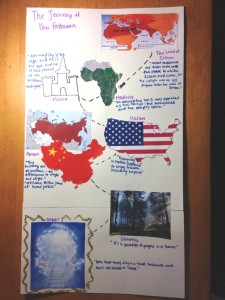“An Allegorical Path” — Collage inspired by “The Journey of Ibn Fattouma”
ø
Explanation:
I found The Journey of Ibn Fattouma very interesting as a work of political and social commentary. I interpreted Ibn Fattouma’s travels to different civilizations as allegorical, with each civilization having a real-world equivalent. His journey seemed to be both a portrayal of the progression of societies from the most primitive (Mashriq) to the most enlightened (Gebel), and a representation of differing political ideologies.
For this piece, I traced Ibn Fattouma’s travels from one civilization to another through symbols of what I interpreted to be their real-world counterparts. I glued maps or symbols of each civilization on to poster paper, wrote their corresponding names and characterizing quotes from the book underneath the images, then drew a dotted line depicting Ibn Fattouma’s path.
I used a map of Dar al-Islam, the expansion of the Muslim world from 900 to 1700 during the era of caliphates, to portray the Land of Islam (Dar al-Islam translates to the Land of Islam in Arabic, and the book references caliphates). I chose sub-Saharan Africa to represent Mashriq, since the narrator mentions traveling south, and sub-Saharan Africa is often seen as an underdeveloped, “primitive” region (although I am wary of oversimplifying or perpetuating this stereotype). For Haira, I drew a castle to depict an absolute monarchy in which the king is seen as God, “the source of all wisdom and good.”
I used a map of the United States filled with the American flag as the equivalent to Halba, since Halba is described as a land of freedom, democracy, and capitalism (“everything in Halba appeared to enjoy freedom, including the prices”). Maps of the Soviet Union and China represent Aman, a place built around the idea of equality and uniformity, where people are given equal pay and strictly controlled by the ruling party (ideas that align with Communism). An image of a forest with sunrays shining through the trees represents Ghuroub, a place of mediation and reflection in nature – “a paradise of people in a trance.”
Lastly, Ibn Fattouma’s ultimate destination, the land of Gebel, is depicted as a staircase to heaven, representing the idea of spiritual ascent. Gebel is a spiritual realm beyond the human world, where people “don’t use senses or limbs,” and the gold glitter I surrounded the image illustrates that it is this spiritual realm that is the end goal of the journey.


